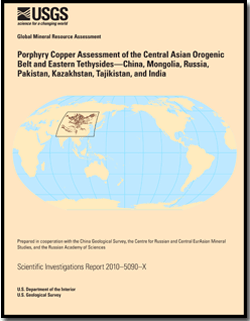Skip Links
Scientific Investigations Report 2010–5090–X
Porphyry Copper Assessment of the Central Asian Orogenic Belt and Eastern Tethysides—China, Mongolia, Russia, Pakistan, Kazakhstan, Tajikistan, and India
By Mark J. Mihalasky, Steve Ludington, Jane M. Hammarstrom, Dmitriy V. Alexeiev, Thomas P. Frost, Thomas D. Light, Gilpin R. Robinson, Jr., Deborah A. Briggs, John Wallis, and Robert J. Miller, with contributions from Arthur A. Bookstrom, Andre Panteleyev, Andre Chitalin, Reimar Seltmann, Yan Guangsheng, Lian Changyun, Mao Jingwen, Li Jinyi, Xiao Keyan, Qiu Ruizhao, Shao Jianbao, Shai Gangyi, and Du Yuliang
 Abstract Abstract
The U.S. Geological Survey collaborated with international colleagues to assess undiscovered resources in porphyry copper deposits in the Central Asian Orogenic Belt and eastern Tethysides. These areas host 20 known porphyry copper deposits, including the world class Oyu Tolgoi deposit in Mongolia that was discovered in the late 1990s. The study area covers major parts of the world’s largest orogenic systems. The Central Asian Orogenic Belt is a collage of amalgamated Precambrian through Mesozoic terranes that extends from the Ural Mountains in the west nearly to the Pacific Coast of Asia in the east and records the evolution and final closure of the Paleo-Asian Ocean in Permian time. The eastern Tethysides, the orogenic belt to the south of the Central Asian Orogenic Belt, records the evolution of another ancient ocean system, the Tethys Ocean. The evolution of these orogenic belts involved magmatism associated with a variety of geologic settings appropriate for formation of porphyry copper deposits, including subduction-related island arcs, continental arcs, and collisional and postconvergent settings. The original settings are difficult to trace because the arcs have been complexly deformed and dismembered by younger tectonic events.
Twelve mineral resource assessment tracts were delineated to be permissive for the occurrence of porphyry copper deposits based on mapped and inferred subsurface distributions of igneous rocks of specific age ranges and compositions. These include (1) nine Paleozoic tracts in the Central Asian Orogenic Belt, which range in area from about 60,000 to 800,000 square kilometers (km2); (2) a complex area of about 400,000 km2 on the northern margin of the Tethysides, the Qinling-Dabie tract, which spans central China and areas to the west, encompassing Paleozoic through Triassic igneous rocks that formed in diverse settings; and (3) assemblages of late Paleozoic and Mesozoic rocks that define two other tracts in the Tethysides, the 100,000 km2 Jinsajiang tract and the 300,000 km2 Tethyan-Gangdese tract.
Assessment participants evaluated applicable grade and tonnage models and estimated numbers of undiscovered deposits at different confidence levels for each permissive tract. The estimates were then combined with the selected grade and tonnage models using Monte Carlo simulations to generate probabilistic estimates of undiscovered resources. Additional resources in extensions of deposits with identified resources were not specifically evaluated.
Assessment results, presented in tables and graphs, show amounts of metal and rock in undiscovered deposits at selected quantile levels of probability (0.95, 0.9, 0.5, 0.1, and 0.05 confidence levels), as well as the arithmetic mean and associated standard deviations and variances for each tract. This assessment estimated a total of 97 undiscovered porphyry copper deposits within the assessed permissive tracts. This represents nearly five times the 20 known deposits. Predicted mean resources that could be associated with these undiscovered deposits are about 370,000,000 metric tons (t) of copper, 10,000 t of gold, 7,700,000 t of molybdenum, and 120,000 t of silver. The assessment area is estimated to contain about five times as much copper in undiscovered deposits as has been identified to date.
This report includes a summary of the data used in the assessment, a brief overview of the geologic framework of the area, descriptions of permissive tracts and known deposits, maps, and tables. A geographic information system database that accompanies this report includes the tract boundaries and known porphyry copper deposits, significant prospects, and prospects. Assessments of overlapping younger rocks and adjacent areas are included in separate reports available on-line at http://minerals.usgs.gov/global/.
|
First posted March 24, 2015
- Report PDF (22 MB)
- Tabloid Figure 1 PDF (15.7 MB)
Map of the study area in central and eastern Asia, showing geographic features mentioned in this report
- Tabloid Figure E1 PDF (826 kB)
[pages 1, 2 of 3] Correlations among geologic time division duration and symbols as used in Russia (Katalog Mineralov, 2005), China (Ma and others, 2002), and Mongolia (Mineral Resources Authority of Mongolia and others, 1998)
Back to Global Mineral Resource Assessment
This publication is online only
Part or all of this report is presented in Portable Document Format (PDF). For best results viewing and printing PDF documents, it is recommended that you download the documents to your computer and open them with Adobe Reader. PDF documents opened from your browser may not display or print as intended. Download the latest version of Adobe Reader, free of charge.
|
Suggested citation:
Mihalasky, M.J., Ludington, Steve, Hammarstrom, J.M., Alexeiev, D.V., Frost, T.P., Light, T.D., Robinson, G.R., Jr., Briggs, D.A., Wallis, J.C., and Miller, R.J., with contributions from Bookstrom, A.A., Panteleyev, Andre, Chitalin, Andre, Seltmann, Reimar, Guangsheng, Y., Changyun, L., Jingwen, M., Jinyi, L., Keyan, X., Ruizhao, Q., Jianbao, S., Gangyi, S., and Yuliang, D., 2015, Porphyry Copper Assessment of the Central Asian Orogenic Belt and eastern Tethysides—China, Mongolia, Russia, Pakistan, Kazakhstan, Tajikistan, and India: U.S. Geological Survey Scientific Investigations Report 2010–5090–X, 106 p. and spatial data, http://dx.doi.org/10.3133/sir20105090X.
ISSN 2328-0328 (online)
Contents
Abstract
Introduction
Terminology
Porphyry Copper Deposit Models
Permissive Tracts for Porphyry Copper Deposits
Assessment Data
Geologic Framework
Exploration History
Tract Delineation
Estimating Numbers of Undiscovered Deposits
Assessment of Tracts in the Central Asian Orogenic Belt and Eastern Tethysides
Assessment of Tracts in the Tethyside Region
Summary of Probabilistic Assessment Results
Discussion
Acknowledgments
References
Appendixes (5)
Figures (44)
Tables (19)